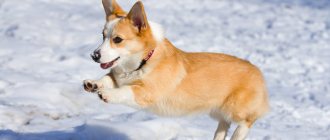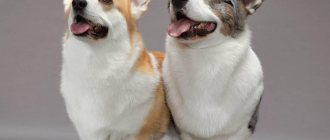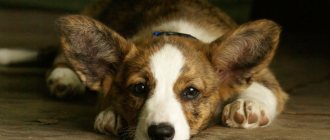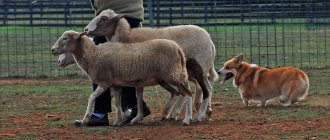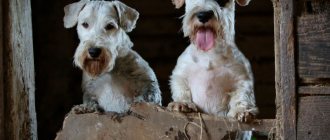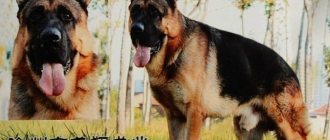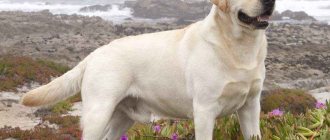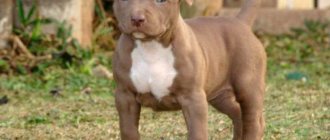A great trendsetter, a favorite of the whole of Great Britain, owner of a huge collection of artsy and classic hats. All this is about one legendary person of the British royal family - Queen Elizabeth II. In addition to her impeccable taste, she is famous for her love for one small breed of dog. Years have passed, the Queen's hats and preferences have changed, but her passion for the Pembroke Welsh Corgi remains unchanged. And, probably, all of Britain was imbued with reverent feelings for these sweetest creatures, calling them the royal breed of dogs.
Queen's Favorite Breed
The Pembroke Welsh Corgi is a funny little dog originally from Wales. She has an interesting elongated muzzle, short legs, rather large ears and very kind, intelligent eyes.
The breed's height is no higher than 30 cm, and its weight is about 14 kg. Outwardly, it is a proportionally built, fairly well-fed animal.
There are 2 main types of breed: the Pembroke Welsh Corgi and the Cardigan Welsh Corgi. The small homeland of the Pembrokes is Pembrokeshire. The Cardigan Corgi begins its lineage in the Cardiganshire district (modern name - Ceredigion).
These are neighboring counties of Wales, separated by a chain of mountains. For this reason, there has never been direct crossing between these breeds.
The cardigan is slightly larger in size (30-35 cm) and has a different head shape. In addition, cardigans have a tail - long and fluffy. Pembrokes are born bobtailed. Also, unlike cardigans, they usually have a red-golden color, and look like a small fox.
The character of the animal is very peculiar. This friendly and energetic dog quickly makes friends with other animals and people. The dog becomes strongly attached to its owner and to other members of the family.
However, at first he is wary of strangers and strangers. May show arrogance and willfulness.
If the Corgi doesn't like something, he will show indifference. But he can also be cheerful and active, trying with all his appearance to show love for a certain person.
Description of the breed
FCI standard No. 39 dated December 1, 2010. “Pembroke Welsh Corgi” Group 1 “Guard and racing dogs (except Swiss Cattle Dogs)” Section 1 “Sheepdogs without working tests”
The Pembroke Welsh Corgi has been an independent dog breed since 1934, along with another variety of the Welsh Corgi, the Cardigan. This is a long-format, tightly built, alert and active dog , full of strength and energy.
For many centuries, the Pembroke Welsh Corgi, like the Cardigan, was used as a herding dog in South Wales. They have now evolved from working dogs to extremely popular and affectionate lap pets.
Although the Pembroke is a born hard worker, he will be quite satisfied with the life of a pet if he is taken for medium-distance walks every day. If physical activity is too small, then this dog quickly loses its slim figure!
A beautiful legend says that a long time ago forest fairies rode corgis.
Dookie is the little princess's first pet
Little Lilibet already dreamed of her own pet at the age of 7. Young Elizabeth first saw cute, cheerful dogs in the house of friends of the Dukes of York - the Marquises of Bath.
Friendly, playful, fluffy corgi puppies with a “smiling” mouth immediately charmed the little girl. There were other dogs in the Duke family. But the girl, having fallen in love with the corgi at first sight, was simply “sick” with the idea of having her own pet.
The parents supported their daughter's wish. Moreover, the breed chosen by the girl belonged to good-natured, non-aggressive dogs that loved children. The Dukes of York went to Thelma Gray's nursery.
The little puppy was the offspring of a purebred Pembroke. Among his brothers, he stood out with his short tail. This is what played a decisive role in the fate of the future four-legged royal favorite. “You need to take a puppy that has something to wag. Otherwise, how will we understand whether he is happy or not?” – the Duke of York explained his choice.
So in 1933, the first corgi, a dog named Dookie, settled into the royal family. Initially, the puppy’s name was more noble - Rosavel Golden Eagle. But the Yorks decided to give him the nickname Duke - Duke. Over time, the dog's name was changed to Dookie for convenience.
Lilibet and her sister Margaret practically never parted with their new friend. Dookie ate from the hands of the little princesses, slept next to them on his own bed and, accompanying the girls everywhere, never let them get bored. The dog often appeared on the pages of newspapers - Dookie looked very funny next to his little mistress.
Soon the Dukes took a corgi girl, Jane, into their home. The purebred dog was also loved by the princesses. But their friendship with Dookie did not work out. Jane was matched with another dog. This is how the royal corgi dogs appeared. They were the boy Crackers and the girl Carol. However, the second died early, and Crackers lived happily until 1953 with the Queen Mother.
In 1939, Duki passed away. Jane lived with the girls at Windsor Castle during wartime. But in 1944, she was hit by a car and died. The girls, who had already lost two of their favorites, took this event very hard.
Exotic pets
Again, as children, Elizabeth and her sister Margaret received a very unusual pet as a gift from their cousin, Lord Mountbatten. He brought the princesses from Asia a chameleon, which was a novelty at that time. The girls were delighted with the reptile's ability to change color and catch flies with its tongue.
The exotic things in the queen’s life did not end there. In 1961, Liberian President Tubman arrived in Britain on a state visit. On his return home, he sent Her Majesty a pair of pygmy hippopotamuses as a gift, which were given to London Zoo.
In general, 1961 was a fruitful year for such gifts. For example, during a visit to the Gambia, the Queen was presented with a crocodile, and it was intended for Prince Andrew. Sir Martin Charteris, the Queen's private secretary, was given the unenviable task of looking after the gift until it returned to Britain. Charteris kept the crocodile in his bathroom, and in his homeland the toothy reptile was also transferred to the zoo.
Photo: FA Bobo/PIXSELL/PA Images/TASS
In 1972, on their silver wedding anniversary, the Queen and Prince Philip received a seven-year-old elephant as a gift. It was sent by the President of Cameroon. The baby elephant named Jumbo had to travel: from Buckingham Palace he was sent to the Children's Zoo at Crystal Palace, then transferred to the London Zoo, and finally he settled at Whipsnade Zoo.
Australia sent the Queen a sloth and at least two kangaroos.
Susan's Favorite
In the same 1944, the heiress to the English throne turned 18. As a gift, her parents decided to give her her first pet of her own. The puppy was named Susan.
It would not be an exaggeration to say that Susan became the future queen’s most beloved dog. Her Highness became so attached to the animal that she could not part with her pet even during her honeymoon, so she took it with her.
Susan became the founder of a large “dynasty” of royal corgi dogs. Willow, the last dog of the Queen of England, was a 14th generation descendant of Sue.
Susan, the ancestor of the royal Pembrokes, died at a respectable age - she was 15 years old. The gravestone under which Elizabeth II’s favorite was buried still bears the inscription: “Susan, the Queen’s faithful friend.”
Results
The Queen announced a “stop” on the issue of breeding court corgis in 2015. This decision was made with only one comment that Elizabeth II did not want to leave her dogs orphans after her death.
At the beginning of 2021, the last purebred Willow, a descendant of the same Susan who was given to Lilibet for her 18th birthday, died. Now only two dogs live in the palace: a cross between a corgi and a dachshund, Candy and Vulcan. The era of the purebred pack of Welsh Corgi Pembroke dogs of the English court has ended.
Royal Corgi Dynasty
During the reign of Elizabeth II, more than 30 royal corgi dogs lived in the palace. Already as an adult, Elizabeth began breeding dogs. She knew almost all English breeders and personally chose a pair for her pets, visiting nurseries.
In the 50s, Elizabeth managed to breed a new, mixed breed of animals. She crossed her corgi girl Tiny with a dachshund dog named Pipekin, who belonged to Margaret, the queen's sister.
The breed of mestizos, to which the queen gave the name Dorgi, has not yet been recognized by dog experts. But for Elizabeth this was not so important.
At different times, the Queen of Great Britain had from 5 to 13 corgi pets living with her at the same time. In 2007, Elizabeth II was surrounded by 5 favorites:
- Emma;
- Willow;
- Monty;
- Linnet;
- Holly.
In addition to the Pembrokes, the queen also kept 5 cocker spaniels and 4 Dorgi mixes. The Queen never presents her four-legged pets at exhibitions.
According to Her Majesty, august dogs do not have to prove their high origins.
Details
It was the Pembroke Welsh Corgi, whose puppy George IV gave to his daughters in 1993, who made his “career” at the English court. Of course, such a charming creature could not leave the hearts of little princesses indifferent. Thus, the Duke of York unintentionally made this ancient herding breed the favorite dog of the English Queen and the entire modern world.
A loyal and loving dog, Duke came from a lineage worthy of royalty - his father, Krimmich President, and mother, Golden Girl, were award-winning show winners from Thelma Gray's private kennel.
A distinctive feature of the puppy was a small tail, although the rest of the litter was kept in the best traditions of the breed and had no tail at all. Later, George IV noted that he took this particular puppy with a tail in order to know for sure whether the dog was happy or not. Also, the royal puppy was extremely long-eared and looked more like a rabbit than a shepherd's helper.
The Queen of England's first personal dog appeared in the palace in 1944, bore the pet name Susan and was a gift for Lilibet's 18th birthday. Later, all the royal corgis of Elizabeth II came from this bitch.
INTERESTING: The Queen owned more than 30 dogs in her entire life, but she never exhibited any of them. Her Majesty’s most important argument is that her pets do not need to prove anything to other dogs, they are already the best. Also, not a single puppy was sold. All the little ones that were not left to live in the palace were given by the queen to her subjects as a sign of the greatest recognition.
The life of royal corgis is truly royal - in the palace they have their own rooms, staff and wardrobe. The feeding of the living corgis in the palace is handled by a separate chef, who prepares the diet of each dog according to personal recommendations. The butler brings porcelain bowls to the dogs, but the dogs do not rush to the food like “ordinary” dogs, but wait for the command of Elizabeth herself. Also, all of Elizabeth II’s dogs very often accompany her at official events and on trips around the country. The queen does not take her pets abroad, since her flock is subject to quarantine for export outside the UK.
Alas, not all members of the royal family share the queen’s reverent love for the breed. And it’s often not just a matter of personal preferences of household members. Royal Welsh corgis, according to princes in interviews and palace staff in private conversations, often behave inappropriately.
If the flock does not like someone, then all as one will bite the “victim” and bully when they meet. Even the dogs of other family members do not evoke tender feelings in the royal fluffies. Royal corgis love only the queen; for them, everyone else is truly their subjects, about whom the dogs can form a positive or negative opinion at their own discretion.
But Her Majesty herself, for the sake of her pets, even decided to change her car in 2005. The fact is that the royal family used jaguars for their transportation for a long time, but at one point the queen decided that the Daimler would be much better suited for transporting her eight dogs, since it could be equipped with a special place for dogs, as well as provide visibility behind the road on the way for short-legged pets.
INTERESTING: once the royal dogs received an inheritance from one British subject equal to 80,000 pounds. But Elizabeth II ordered these funds to be sent to a dog shelter. She did this not only out of love for dogs and out of a desire to help the underprivileged tails of the kingdom, but also because she was upset that someone felt that she was unable to provide for her pets in a dignified manner.
Perhaps the cutest, but also the most tragic feature of the Queen's life side by side with her corgis is the presence of a separate cemetery for the royal dogs at Sandringham Palace. There, each Pembroke who left this world has his own plaque and a message from his owner.
In general, the dog of the English Queen has long become an unspoken part of the national heritage and a symbol of the reign of Elizabeth II. Porcelain decorative plates, cups, bowls, badges and commemorative cards - all this can be found in large quantities in specialized souvenir shops across the country.
But the most striking example of popular love for the Welsh Corgi dog breed can be called a special anniversary cookie, which was produced in the year of the 60th anniversary of the Queen’s reign. Even street artists do not shy away from this topic - in the center of London there is graffiti depicting Her Majesty and her Pembroke. In 2021, the animated film “Royal Corgi” from a Belgian studio was released.
But the Queen’s heart is open not only to her personal pack; in 2017, she became the adoptive “mother” to a corgi named Winsper, who was once given to her as a gift to the palace gardener. After the death of the courtier and his wife, the dog was left an orphan and the royal heart did not allow him to be given to a shelter, she took him to her place, especially since her dogs had known Winsper for a long time and accepted him into the pack.
Heirs to the throne, but not a hobby
A whole book could be written about Elizabeth II’s friendship with purebred corgis. For the Queen, corgis have always been and remain more than just a hobby.
Dogs have always accompanied the crowned lady at all kinds of official receptions and social events. That is why funny pets with short legs became an integral part of the royal image of Elizabeth II, along with the crown and bright suits.
In national culture, the Great English ruler is always presented in the company of a cute fluffy corgi. There are several monuments to this breed of dog in the Commonwealth countries.
In 2012, at the opening of the Olympic Games in London, Her Majesty appeared surrounded by her four-legged pets. The hostess starred in a short film about James Bond, where Monty, Holly and Willow, the Queen’s irreplaceable companions, participated with her.
The theme of the relationship between the queen and her pets excites the imagination of artists, sculptors, confectioners and even souvenir manufacturers:
- Photos of the royal Pembrokes are depicted on dishes, calendars, postcards, posters, and T-shirts.
- Sculptor David Marshall immortalized Elizabeth's love for her pets. In the city of Christchurch (New Zealand) there is now a sculpture - three corgis walking one after another. Moreover, the dogs are presented in life-size. The monument was opened on the 50th anniversary of the Queen of England.
- In 2002, to mark the 50th anniversary of his accession to the throne, a coin with the image of a corgi was minted.
- In London, a monument was erected to the Queen, next to which are her two pet corgis (2009). In the same London, in the city center there is a wall with graffiti - a queen with a dog, this is the work of artist Thierry Guetta from Los Angeles.
- In 2011, a British designer made a dog cake with corgi figures from dry food.
- In 2012, for the anniversary of the coronation of Elizabeth II, confectioners made a delicious treat - corgi cookies.
- “The Queen and the Welsh Corgi” is the name of the Alderney coin released in 2013. Moreover, the dog is depicted in the foreground.
- And finally, in 2021, the cartoon “Royal Corgi” was released. The touching story taken as the basis of the film should appeal to viewers of any age. After all, this is a representation of a real 20th century phenomenon.
Corgis are not just favorite dogs for the queen. This is a whole era in the life of Elizabeth II. And for adherents and admirers of the English first lady, the royal corgis are the real heirs to the throne. It’s not for nothing that in many photos and paintings four-legged pets are depicted wearing crowns.
Pomeranian Spitz
Before the advent of the corgi, Pomeranians could be seen in the royal palace. Adorable dogs were the weakness of Queen Victoria, who bred them.
Photo source:
You will be surprised, but the small size of the Spitz is a merit of Her Majesty, because the first “bears” were the size of a malamute, husky and chow-chow. Thanks to the Queen, new standards for Pomeranian Spitz were approved, and Her Majesty even opened a club for the sake of miniature dogs.
Photo source:
Knowledgeable people claim that Victoria liked pets of red and sand colors most of all. Their unbridled temperament, liveliness and cheerful disposition brought the queen into indescribable delight.
Considering that the royal often suffered from postpartum depression and showed dissatisfaction with many things, the cheerful dogs really became a source of positivity for her.
A Royal Dog's Life
Royal corgis live, as befits the true heirs to the throne, in complete comfort. At Buckingham Palace, dogs have separate apartments. There is a bedroom, a dressing room, a bathroom.
The dog's bedroom contains wicker baskets with soft silk pillows. To prevent the animals from catching a cold at night from drafts, the baskets were hung above the floor.
The royal pets have a lot of clothes in their wardrobe. The dogs have their own trainer who trains the four-legged fidgets and walks with them. The palace also employs a chef, whose responsibilities include ensuring the proper diet of the animals.
The dogs are fed from porcelain and silver dishes. The pet menu includes steaks, dog biscuits, lean rabbit meat and chicken. The best veterinarians monitor the health of the Royal Corgis. To prevent diseases, vitamins are added to dogs' food.
When time allowed, the queen loved to feed her pets herself. I walked with dogs and trained them. When feeding, Elizabeth taught the corgi to eat in turns - first the older pets were allowed to eat, and then the younger pets.
According to the Queen's son, Duke Andrew of York, Elizabeth's four-legged pets give her the energy to live. Despite her already venerable age, Her Majesty always took care of dogs herself.
At Christmas, all the royal pets received gifts from their beloved mistress - festive socks with treats and toys. In 2005, the Queen abandoned her usual Jaguar, explaining that it would be uncomfortable for her 8 corgis to ride in it.
Elizabeth II chose the Daimler, which has a spacious place for dogs, from where pets can see what is happening outside the car window.
The queen's corgis walk freely through the palace halls, frolic in parks, attend official receptions with their mistress, and travel in carriages, limousines and trains.
All royal pets are buried in a special cemetery near Sandringham Palace. Each pet is given a small tombstone with memorable inscriptions. This rule was established by the mother of the current Queen of England.
Maintenance and care
Care is simple: feed properly and be sure to brush it once a week. And the content does not require special conditions. The main thing is that the walks are long and active.
Corgis are not the type of dog that will go outside just to empty their bowels and bladder. She needs to run, jump and for a long time in order to splash out all the accumulated energy. If this dog from England does not “give all its best” on a walk, he will do it at home. And then don’t be surprised that the room is upside down.
